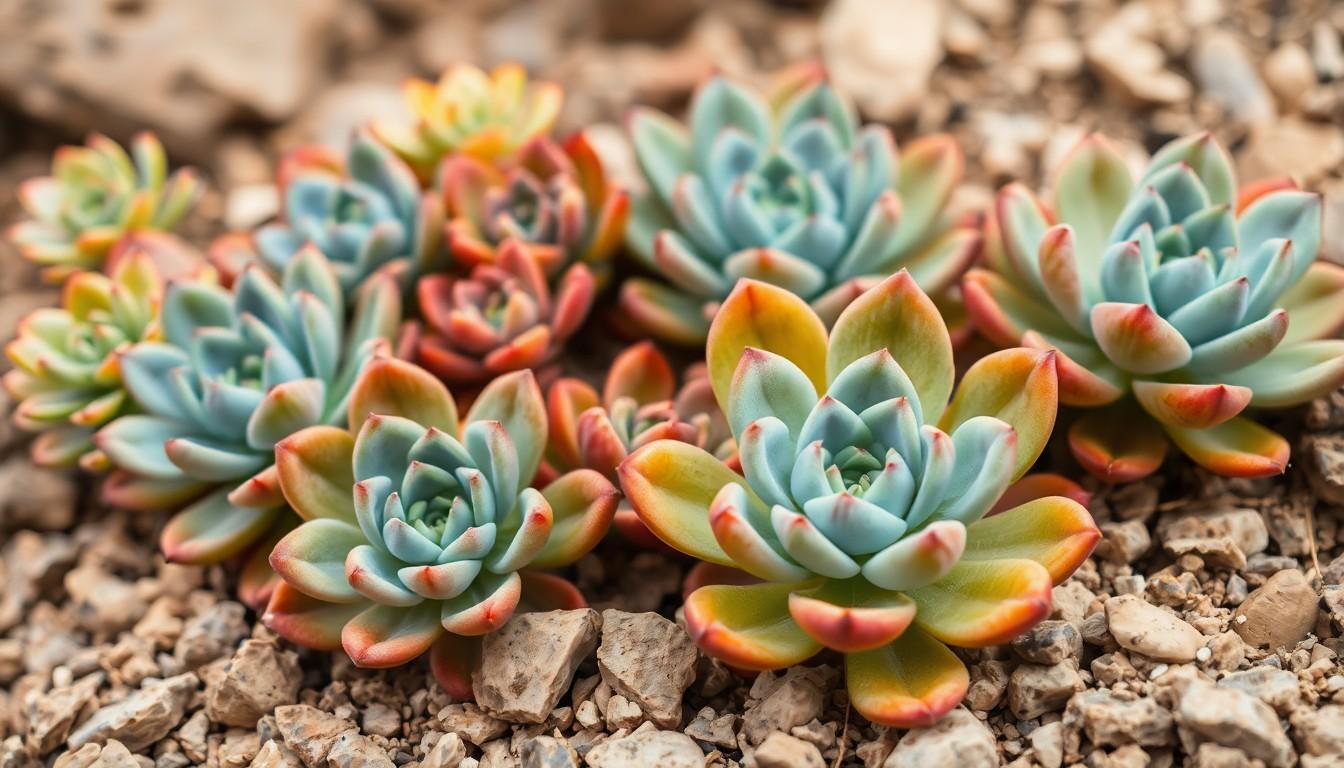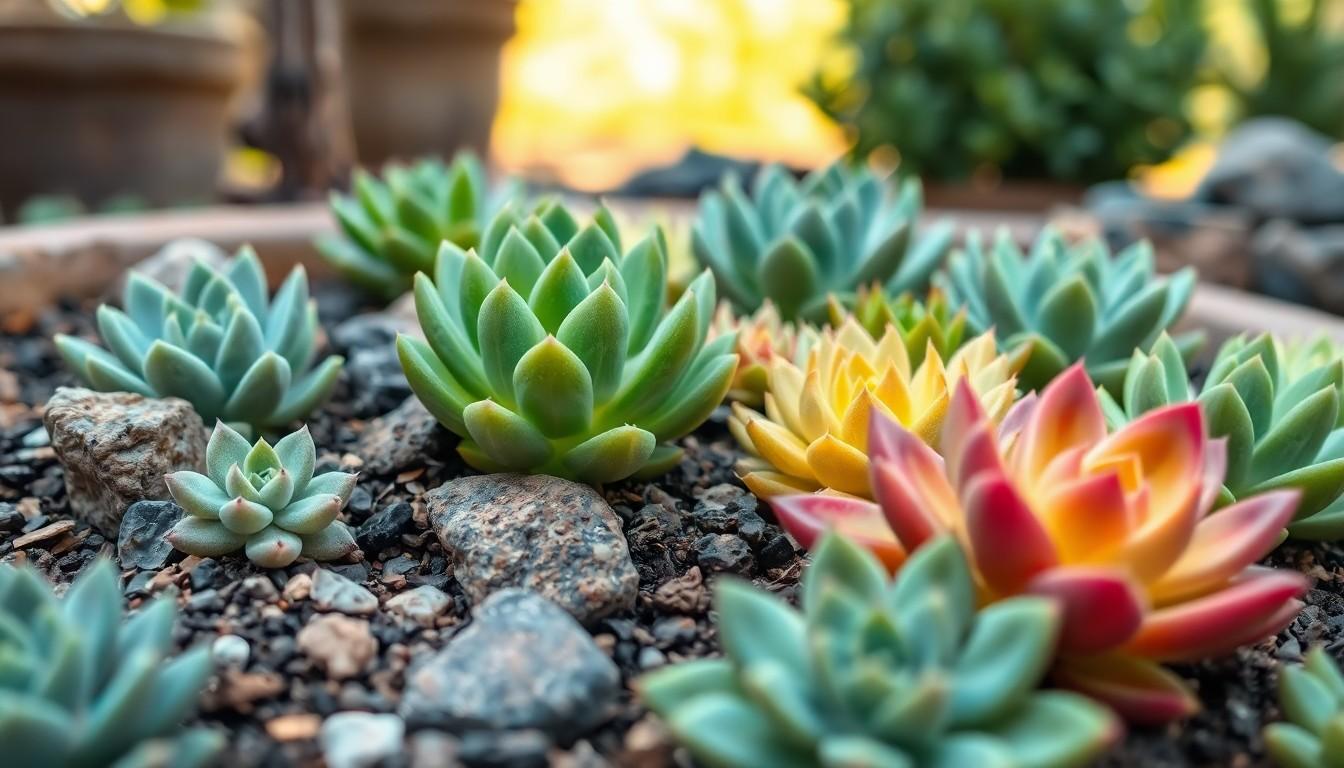Lithop succulents, often dubbed “living stones,” are the ultimate conversation starters for plant enthusiasts. With their quirky, rock-like appearance, they might just convince you that your houseplants have been moonlighting as boulders. These fascinating little gems are not only low-maintenance but also bring a unique charm to any space.
Overview of Lithop Succulents
Lithop succulents, often referred to as “living stones,” possess a remarkable ability to blend into their surroundings. These plants thrive in arid environments, showcasing adaptations that help them conserve water. Each lithop consists of paired leaves, resembling pebbles or rocks, enabling effective camouflage against predators.
Growing lithops does not require extensive care. They prefer well-draining soil and require infrequent watering, particularly during their dormancy in winter. Bright, indirect sunlight promotes healthy growth, allowing these succulents to flourish indoors or outdoors.
Plant enthusiasts appreciate the diverse coloration of lithops. Ranging from green, yellow, and brown to shades of red, these plants can adapt their colors based on environmental conditions. A garden featuring a variety of lithops creates a striking visual appeal.
Propagation of lithops occurs through seed or leaf division. Seeds require specific conditions for germination, including warmth and appropriate lighting. Leaf division, while less common, can effectively help expand a lithop collection.
Various species exist within the lithop family. For example, Lithops lesliei displays a greyish-green body with intricate patterns, while Lithops fulviceps sports vibrant yellow hues. Identifying species enhances the appreciation of their unique characteristics and growing habits.
Caring for lithop succulents results in rewarding experiences for plant lovers. Their low-maintenance requirements and unique designs captivate admirers, establishing them as popular choices among succulent collections.
Characteristics of Lithop Succulents

Lithop succulents exhibit fascinating traits that contribute to their distinctiveness and adaptability in arid environments.
Unique Appearance
Lithops display a captivating rock-like appearance, resembling small pebbles scattered across the landscape. Each plant consists of two thick leaves that form a unique split, allowing them to mimic their surroundings. The surface texture ranges from smooth to rough, which enhances their camouflaging abilities. Colors vary widely among species, including greens, browns, yellows, and reds. Healthy lithops often showcase vibrant hues, adapting based on light exposure and environmental factors. This natural artistry attracts collectors and plant enthusiasts, who appreciate the aesthetic value lithops bring to succulent arrangements.
Adaptations to Environment
Lithops possess remarkable adaptations that enable survival in arid habitats. Thick leaves store moisture, allowing the plants to endure prolonged dry periods. Shallow root systems efficiently absorb rainwater, minimizing water loss. Photosynthesis primarily occurs through leaf surfaces, which reduces the need for extensive leaf growth. They initiate dormant phases during winter, relying on stored water and energy reserves. Low light requirements suit them well, as they thrive under bright indirect light conditions. The unique ability of lithops to blend into rocky landscapes offers protection from grazing animals, ensuring their survival in harsh environments.
Growing Lithop Succulents
Growing lithop succulents is a rewarding endeavor for plant enthusiasts. These unique plants thrive in specific conditions that mimic their natural habitats.
Ideal Growing Conditions
Lithops require well-draining soil such as cactus mix or a blend of sand and potting soil. Bright, indirect sunlight promotes optimal growth, making window sills or spots with filtered light ideal. Temperatures between 65°F and 80°F suit lithops well, though they can tolerate slightly cooler conditions. Humidity should remain low, preferably below 50%, to prevent root rot. Watering should occur infrequently, allowing soil to dry completely between sessions. Dormancy takes place during winter, meaning water should be minimal during this time. These careful considerations ensure healthy lithop succulents.
Common Mistakes to Avoid
Overwatering leads to the most common error when caring for lithops. Watering too frequently can cause root rot, a condition that affects plant health. Using non-draining pots contributes to moisture retention, which lithops cannot tolerate. Ignoring dormancy periods results in unnecessary stress for the plants. Neglecting sunlight needs can also hinder growth; placing them in overly dark areas stunts their development. Lastly, crowding lithops can limit airflow, increasing the risk of disease. Being aware of these mistakes helps maintain vibrant and thriving lithop collections.
Care and Maintenance
Caring for lithop succulents involves understanding their specific needs to thrive. Proper watering, soil, and fertilization contribute significantly to their health.
Watering Techniques
Watering lithops requires a precise approach. During the growing season, typically spring and summer, they need watering every 2 to 3 weeks. Drench the soil thoroughly, allowing excess water to drain. During winter dormancy, reduce watering significantly, potentially once a month or less, depending on environmental conditions. Observing the leaves can provide critical insight; if they begin to shrivel, it indicates a need for water. Always choose to water when the soil is completely dry to prevent root rot.
Soil and Fertilization
Selecting the right soil mix is essential for lithops. A gritty, well-draining soil mix suited for cacti or succulents works best. Consider combining standard potting soil with sand or pumice in a 1:1 ratio for optimal drainage. Fertilization should occur carefully; during the growing season, a diluted, balanced fertilizer used once or twice is adequate. Avoid fertilizing during winter when lithops are dormant. Ensuring these conditions helps lithops flourish and show their unique beauty.
Propagation of Lithop Succulents
Propagation of lithop succulents occurs through two primary methods: seed and leaf division. Seed propagation involves collecting seeds from mature plants. Seeds require specific conditions for successful germination, including warmth and moisture. They should be sown in well-draining soil, preferably composed of sand and perlite.
Leaf division provides an alternative approach. To perform this method, a healthy leaf can be carefully cut from the parent plant. After cutting, the leaf needs to callus for a few days before planting in soil. Maintaining moisture is crucial during this process, promoting root development.
Timing plays a significant role in successful propagation. Early spring serves as the optimal season for both methods, aligning with natural growth cycles. Temperature, ideally between 70°F and 80°F, supports seed germination and root establishment. Ensuring light exposure during this period aids in strengthening young plants.
Care after propagation requires attention. Seedlings thrive under bright, indirect light while avoiding direct sunlight, which can be too intense. Newly planted leaves necessitate similar lighting conditions to prevent scorching.
Monitoring moisture levels remains essential throughout the propagation phase. Overly wet soil can lead to rot, while dry conditions hinder growth. Regular checks on soil moisture encourage healthy root formation.
By understanding these propagation techniques, enthusiasts can expand their lithop collection. Proper care during the initial stages fosters growth and enhances overall aesthetic appeal. Utilizing these methods promotes the successful cultivation of lithops, allowing their captivating beauty to flourish.
Conclusion
Lithop succulents offer a unique blend of beauty and resilience that appeals to plant lovers everywhere. Their striking appearance and low-maintenance requirements make them perfect for both novice and experienced gardeners. With the right conditions and care, these fascinating plants thrive, adding a touch of natural artistry to any space.
Whether growing them indoors or outdoors, lithops bring a distinctive charm that sparks curiosity and admiration. Their adaptability to harsh environments showcases nature’s ingenuity, making them a worthwhile addition to any collection. As enthusiasts explore propagation techniques and care strategies, they can enjoy the rewarding experience of nurturing these remarkable living stones.

